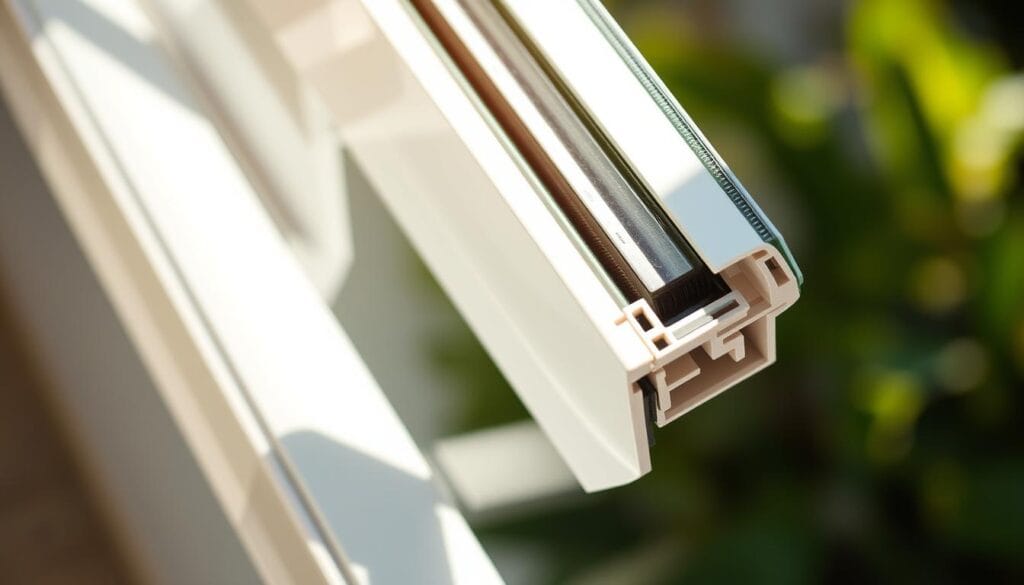“Design is not just what it looks like and feels like. Design is how it works.” – Steve Jobs perfectly captures the essence of innovative building materials like uPVC that go beyond aesthetic appeal.
Modern construction demands materials that offer robust protection against environmental challenges. uPVC (unplasticized polyvinyl chloride) has emerged as a revolutionary solution in the Indian building market. It addresses concerns about termite resistance.
Homeowners and construction professionals are increasingly exploring uPVC termite resistance. They see it as a critical factor in material selection.
Termite-proof uPVC windows and uPVC doors termite protection represent cutting-edge technology in building design. The material’s unique chemical composition provides a barrier against these destructive pests. This makes uPVC construction termite barrier an attractive option for sustainable infrastructure.
Key Takeaways
- uPVC offers advanced protection against termite infestations
- Chemical composition makes uPVC inherently resistant to pest damage
- Ideal for long-term structural integrity in building projects
- Provides a durable alternative to traditional building materials
- Cost-effective solution for termite prevention
Understanding uPVC as a Building Material
uPVC (unplasticized Polyvinyl Chloride) has changed the game in modern building. It’s known for being termite-resistant. This makes it great for keeping homes safe from termites and for green building.

Architects and builders are now choosing uPVC over old materials. It’s a top pick for keeping buildings safe from termites.
Unique Material Characteristics
uPVC is different from other materials in several ways:
- It lasts a long time, even in tough weather
- It’s very good at keeping termites away
- It needs little care
- It doesn’t break down easily
Chemical Composition and Termite Resistance
The way uPVC is made helps it fight off termites. Termite-proof uPVC flooring and uPVC furniture termite shield show how well it’s designed.
Benefits in Construction
Using PVC in building has many benefits:
- It makes buildings stronger
- It saves energy
- It keeps termites out for a long time
- It’s good for the environment
For those looking for reliable termite protection, uPVC is a smart choice. It’s a solid investment for keeping your home safe.
Is uPVC Termite Proof?
Keeping homes safe from termites is a big deal in India. uPVC materials are a strong defense against these pests. They are better than wood because they don’t attract termites.

uPVC is made in a way that termites can’t harm it. This makes uPVC windows and doors great at keeping termites out. Here’s why uPVC is a good choice:
- It’s not made of organic stuff
- It doesn’t have cellulose, which termites like
- It lasts a long time and needs little care
Even though uPVC is good at keeping termites away, it’s not foolproof. Keeping homes safe from termites needs a full plan. Homeowners should also:
- Check their homes often
- Make sure water drains well
- Get rid of wood near buildings
- Use professional termite treatments
Experts say using uPVC in homes is a smart move. It helps keep termites out. This makes it a great choice for building today.
uPVC: Your first line of defense against termite damage
Choosing uPVC for your home means less worry about termites. It lasts longer and costs less to keep up. It’s a smart way to protect your home for years to come.
Conclusion
uPVC is a strong choice for homes to fight termites. Its special mix keeps pests away, making it key for those wanting to protect their homes.
Now, experts see uPVC as a big help in fighting pests. It’s not perfect, but it’s a big step in stopping termites from harming buildings. This means homes and buildings can last longer.
Choosing uPVC needs careful thought about the place and how it’s built. Getting advice from experts is important to use it right in homes and businesses.
If you want to use uPVC in your home, talk to WeatherSeal experts. Call +91 767651 9999 or email sales@weatherseal.in. They can help with pest solutions that fit your needs.
FAQ
Is uPVC completely termite-proof?
uPVC is very resistant to termites but not completely proof. It’s made of non-organic materials that termites don’t like. But, if there are wooden or cellulose-based materials nearby, termites might find a way around it.
How does uPVC protect against termite damage?
uPVC’s chemical makeup acts as a natural barrier against termites. It doesn’t have cellulose, which termites need to eat. So, it’s a great choice for windows, doors, and other parts of buildings.
Can termites eat through uPVC?
No, termites can’t eat through uPVC. Its synthetic and hard structure stops them. But, they might try to go around uPVC to get to other parts of a building.
Where can uPVC be used to prevent termite damage?
uPVC is good for many uses to prevent termites. It works well in window frames, door frames, siding, flooring, furniture, and more. It’s a smart choice in areas where termites are common.
Is uPVC better than traditional wood for termite protection?
Yes, uPVC is much better than wood for keeping termites away. Wood attracts termites and can get damaged easily. uPVC is durable and doesn’t attract termites, making it a better choice.
Do I need termite treatment if I use uPVC?
Even though uPVC is good at keeping termites away, it’s wise to have a full plan to prevent termites. This includes regular checks, keeping moisture levels right, and treating the area around uPVC to protect against termites.
Are there any limitations to uPVC’s termite resistance?
The main limit is that termites might find other ways into a building through other materials. Also, uPVC should be part of a bigger plan to manage pests, as it can’t protect against termites all by itself.
How long does uPVC’s termite resistance last?
uPVC stays termite-resistant for its whole life, which can be 20-30 years or more. It doesn’t get weaker or more attractive to termites over time. So, it’s a reliable choice for keeping pests out.

